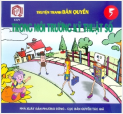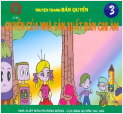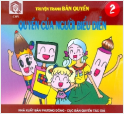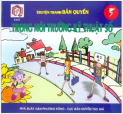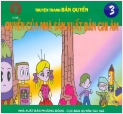Thursday, 16-11-2023 02:24

New highlights of copyright and related rights of the Law amending and supplementing a number of articles of the Law on Intellectual Property in 2022
On June 16, 2022, the National Assembly promulgated Law No. 07/2022/QH15 on amending and supplementing a number of articles of the Law on Intellectual Property including 4 Articles, effective from January 1, 2023, except for the case where the provision on trademark protection is a sound sign that takes effect from January 14, 2022 and the regulation on protection of test data used for agricultural products takes effect effective Jan. 14, 2024.
The purpose of amending and supplementing a number of articles of the Law on Intellectual Property is to institutionalize the guidelines and lines of the Party and the State’s policies on perfecting the IP institution; overcoming problems and inadequacies in practice for 16 years of implementation; institutionalize and internalize commitments to conform to international practices; thereby perfecting the institution of intellectual property in the direction of encouraging creativity, ensuring stability, uniformity, synchronization, transparency, feasibility, intellectual property rights are effectively protected and enforced, and at the same time improving the effectiveness and effectiveness of the State management of intellectual property, contribute to promoting the economic, cultural and social development of the country.

Third session of the 15th National Assembly, June 16, 2022
New highlights of copyright and related rights of the Law amending and supplementing a number of articles of the Law on Intellectual Property in 2022:
- Amending and supplementing a number of terms in the Law on Intellectual Property
According to the amended Intellectual Property Law 2022, some of the following wording have been changed:
– A derivative work is a work created on the basis of one or more existing works through translation from one language to another, adaptation, compilation, annotation, selection, arrangement, musical adaptation and other adaptations.
(Compared to current texts, derivative works are works translated from one language to another, works of adaptation, adaptation, compilation, annotation, selection)
– Published works, sound recordings or video recordings are works, sound recordings or video recordings that have been released with the consent of the copyright owner or the owner of relevant rights in order to disseminate to the public copies in any form in reasonable quantities. (Compared to the current text, replacing the formal phrase of the copy is any form).
– Copying is the creation of copies of all or part of a work or sound or video recording by any means or form. (Compared to the current document, there is no longer a regulation for one or more copies, instead adding provisions for the creation of all or part of a work; no longer specifically covering electronic form).
– Royalty is money paid for the creation or transfer of copyright, related rights to works, performances, sound recordings, video recordings, broadcasts, including royalties and remuneration. (What’s new).
– Technological measure to protect rights means a measure to use any technique, technology, equipment or components in the course of normal operation that has the main function of protecting copyright or related rights for acts performed without the permission of the copyright owner, relevant rights holders. (What’s new).
– Effective technological measure means a technological measure to protect the right of copyright holders and related rights to control the use of works, performances, sound recordings, video recordings, broadcasts, satellite signals carrying encrypted programs through access control applications, protection processes or copy control mechanisms. (What’s new).
– Rights management information means identifying information about works, performances, sound recordings, video recordings, broadcasts, satellite signals carrying encrypted programs; about authors, performers, copyright owners, related rights owners and conditions of exploitation and use; number and code showing the above information. Rights management information must be associated with a copy or appear simultaneously with a work, performance, sound recording, video recording, broadcast when the work, performance, sound recording, video recording, broadcast is transmitted to the public. (What’s new).
– Communication to the public is the transmission to the public of a work; sounds, images of the performance; sounds, images or reproductions of sounds or images shaped in sound recordings or video recordings by any means other than broadcast. (What’s new).

At the 3rd session of the 15th National Assembly, June 16, 2022, the Law amending and supplementing a number of articles of the Intellectual Property Law was approved with a rate of 95.58%.
- Add content about the author, co-author
In Article 12a of the Law amending and supplementing a number of articles of the Law on Intellectual Property in 2022 stipulates authors and co-authors as follows:
– The author is the person who directly creates the work. (Compared to Decree 22/2018/ND-CP, the regulation no longer stipulates that the author is the creator of part or all of the work; no longer clearly stipulates that the work is a literary, artistic and scientific work). Where two or more people directly create the work with the intention that their contribution is combined into a complete whole, those people are co-authors. (Compared to the current Decree 22/2018/ND-CP, co-authors are authors who directly create part or all of literary, artistic and scientific works).
– The person who supports, comments or provides materials for others to create works is not the author or co-author.
– The exercise of moral and property rights to works with co-authors must be agreed by the co-authors, unless the work has a separate part that can be separated and used independently without prejudice to the part of other co-authors or otherwise provided for by other laws. (What’s new).
- Supplementing the moral rights of the author
In Article 19 of the Law amending and supplementing a number of articles of the Law on Intellectual Property in 2022 stipulates the moral rights of authors as follows:
Specifically, the moral rights of the author include:
– Name the work.
Authors have the right to transfer the right to use the right to name works to organizations or individuals receiving the transfer of property rights specified in Clause 1, Article 20 of the Law on Intellectual Property. (What’s new).
– Put your real name or pseudonym on the work; be given a real name or pseudonym when the work is published or used.
– Publish the work or allow others to publish the work.
– Protect the integrity of the work from being misrepresented by others. Do not allow others to modify or mutilate the work in any way that harms the honor and reputation of the author.
- Addition of exceptions that do not infringe copyright
Article 25 of the Law amending and supplementing a number of articles of the Law on Intellectual Property in 2022 stipulates exceptions for non-infringement of copyright as follows:
– Cases of using published works without permission, without paying royalties, but must provide information about the author’s name and the origin and origin of the work, including:
+ Self-copying a copy for personal scientific research and study and not for commercial purposes. This provision does not apply in the case of copying using a copying device.
(Compared to the current text, additional use cases for learning; additionally requiring the above schools to be non-commercial; Additional exclusions)
+ Reasonably copying a part of the work by copying equipment for scientific research and learning of individuals and not for commercial purposes; (What’s new).
+ Rational use of works for illustration in lectures, publications, performances, sound recordings, video recordings, broadcasts for teaching purposes. Such use may include provision in an internal computer network provided that technical measures are in place to ensure that only learners and teachers in that session have access to this work.
+ Using works in official activities of state agencies; (What’s new).
+ Reasonably quote the work without misrepresenting the author to comment, introduce or illustrate in his/her work; for writing newspapers, used in periodicals, in broadcasts, documentaries.
+ Using works in library activities for non-commercial purposes, including:
Copy works stored in libraries for preservation, provided that such copies must be marked as archival copies and limited to objects of access in accordance with the law on libraries and archives;
Reasonably copy a part of the work with copying equipment for others for research and study;
Reproduction or transmission of works preserved for interlibrary use via computer networks, provided that:
The number of readers at any one time shall not exceed the number of copies of the work held by the aforementioned libraries, except as permitted by the rights owner, and this does not apply in cases where the work has been made commercially available in digital form;
(Additional rules for the number of readers at the same time)
+ Performing theatrical works, music, dance and other forms of art performances in cultural events, propaganda activities for non-commercial purposes;
+ Taking photographs and television of works of fine art, architecture, photography and applied arts displayed in public places in order to introduce images of such works, not for commercial purposes;
+ Importing copies of other people’s works for personal use, not for commercial purposes;
+ Reproducing by reposting in newspapers, periodicals, broadcasting or other forms of communication to the public lectures, speeches or other speeches presented to the public to the extent suitable for current information purposes, unless the author claims to hold copyright; (What’s new).
+ Taking photos, recordings, videos and broadcasting events for the purpose of news reporting, including using works heard and seen in that event; (Compared to current text, additional photographic behavior).
+ People with visual disabilities, people with disabilities who are unable to read printed words and other people with disabilities who are unable to access works to read in the usual way (hereinafter referred to as people with disabilities), people who nurture and care for people with disabilities, organizations that meet the conditions prescribed by the Government to use works as prescribed in Article 25a of the Law on Ownership intellect.
– The use of the work specified in Clause 1 of this Article must not contradict the normal exploitation of the work and must not cause unreasonable damage to the legitimate interests of the author or copyright owner.
– The copying specified in Clause 1 of this Article does not apply to architectural works, fine art works or computer programs; the work of anthologies and anthologies of works.

- Changes in dossiers of copyright registration and related rights registration
Pursuant to Clause 2, Article 50 of the Law amending and supplementing a number of articles of the Law on Intellectual Property in 2022 stipulates the dossier of copyright registration and related rights registration as follows:
– Declaration of copyright registration, registration of related rights.
+ The declaration must be made in Vietnamese with full information about the applicant, author, copyright owner or related right owner;
+ Completion time; (What’s new)
+ Summary of the content of works, performances, sound recordings, video recordings or broadcasts;
+ Name of author, copyright owner, work used as a derivative work if the registered work is a derivative work;
+ Time, place and form of announcement;
+ Information on re-issuance, exchange (if any), commitment of responsibility for the information stated in the declaration.
(Compared to current, more information on re-issuance, renewal)
+ The declaration is signed by the author, copyright owner, related right owner or pointer, except in case of physical inability to sign or point. (What’s new)
The Minister of Culture, Sports and Tourism shall prescribe the form of declaration of copyright registration and related rights registration;
– Two copies of works registered for copyright or two copies of the object of registration of relevant rights;
– Power of attorney, if the applicant for registration of copyright or registration of the relevant right is an authorized person;
– Documents proving that the owner of the right due to self-creation or due to assignment of creative tasks, entering into creative contracts, inheritance or transfer of rights;
– Written consent of co-authors, if the work has co-authors;
– Written consent of the co-owners, if the copyright or related rights are jointly owned.
- Supplementing the form of submitting copyright registration dossiers
Pursuant to Clause 1, Article 50 of the Law amending and supplementing a number of articles of the Law on Intellectual Property in 2022 stipulates the dossier of copyright registration and related rights registration as follows:
Authors, copyright owners and related rights owners may directly or authorize other organizations or individuals to submit dossiers for copyright registration or related rights registration in direct ways, via postal services or through the online Public Service Portal to the state management agency in charge of copyright, relevant rights. (Compared to the current document, add the application form through the Online Public Service Portal or the postal service).
COV



 VN
VN






 Director General’s Message for World IP Day 2025
Director General’s Message for World IP Day 2025

